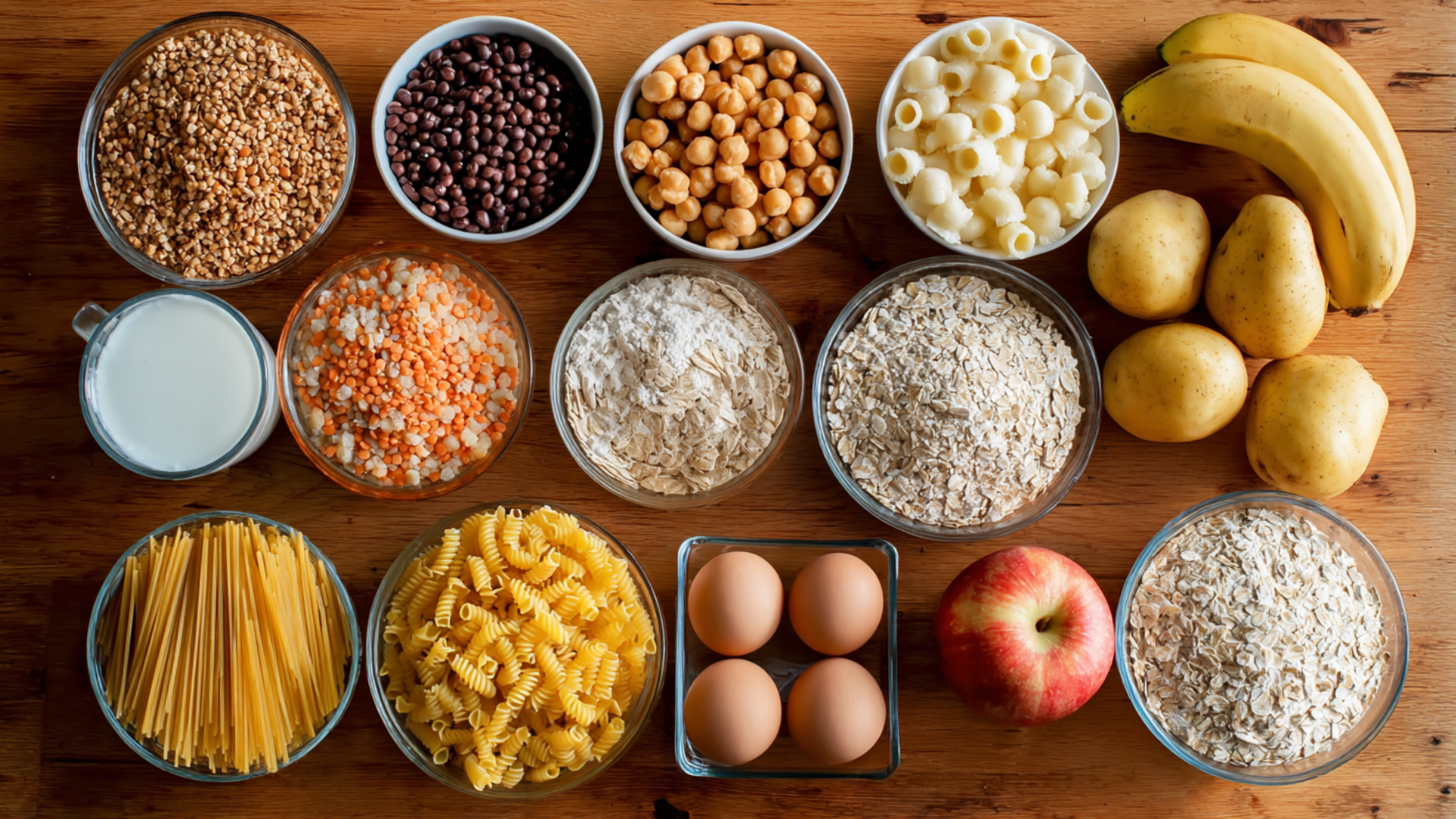Have you noticed how your grocery bill seems to climb higher every month, even when you buy the same items?
Food prices have been rising steadily, and for many households, this puts serious pressure on the budget. The good news is that there are simple ways to cut costs without sacrificing healthy, filling meals.
In this blog, I’ll walk you through practical strategies for grocery shopping on a budget, from setting a realistic spending plan to meal prepping, shopping smarter, and reducing waste.
You’ll also find sample grocery lists, meal ideas, and clever hacks to make every dollar stretch further at the store.
Average Grocery Costs
Grocery spending varies by location, family size, and food choices.
In 2025, rising prices continue to strain budgets, with U.S. households spending about $975–$1,150 per month for a family of four. Smaller households may spend closer to $300–$500 monthly.
Planning ahead and allowing for inflation helps keep costs manageable.
Setting a Realistic Grocery Budget

Before saving, set a grocery budget that fits your lifestyle. Track what you spend each week, then adjust for income, household size, and food needs. Adding a small buffer helps you manage rising prices while keeping meals affordable.
Budgeting methods can make shopping easier.
- The 50-30-20 rule splits income into 50% needs, 30% wants, and 20% savings or debt.
- The 3-2-1 method keeps lists simple with three veggies, two proteins, and one grain.
- A variation, the 5-4-3-2-1 method, uses five veggies, four fruits, three proteins, two spreads, and one grain.
These aren’t strict rules – just flexible tools to guide smarter spending
Budgeting by Household Size
Your grocery budget changes depending on how many mouths you’re feeding.
| Household Type | Budget Guideline | Notes / Adjustments |
|---|---|---|
| Single person | Start with 30–50% more than your baseline food cost | Single people often pay more per unit |
| Couple | ~1.7× the single-person budget | Some cost savings happen from shared staples |
| Family (3–5 people) | Multiply the per-person cost by household count, then add a 10-20% buffer | Kids may eat different foods or more snacks |
Quick tip: Plan for an extra margin (10-15%) in your budget. Food prices fluctuate, and you don’t want to run short mid-month.
Smart Grocery Planning: Step-by-Step
Good planning is the backbone of grocery shopping on a budget. It helps you waste less food, resist impulse buys, and make the most of every dollar.
Before heading to the store, follow this simple routine:
Step 1: Check your pantry and fridge
Start by looking at what you already have on hand. Many people buy duplicates simply because they forget what’s tucked away in the back of a cabinet or drawer. Use items that are close to expiring first, and build some of your meals around them.
Step 2: Make a list
Once you know what’s left in your pantry, write down only what you need to complete the week’s meals. Group items by category – produce, dairy, pantry, frozen – so your shopping trip is quicker and less stressful.
Step 3: Stick to the list
This is where discipline saves you the most money. Avoid tossing extras into your cart just because they look good or are marked “on sale.” If it wasn’t part of your plan, you probably don’t need it right now.
This habit makes shopping faster, easier, and far more affordable.
Shopping Strategies That Actually Work
Smart shopping habits can save you more than clipping coupons. These simple strategies help you get more value for every dollar.
1. Compare Unit Prices, Read Labels, Avoid Impulse Buys
- Unit prices show cost per ounce, pound, or liter. The bigger pack isn’t always cheaper.
- Read labels to check ingredients and serving sizes. A “deal” isn’t worth it if it’s mostly filler.
- Impulse buys often wreck your budget. Stick to your list and skip checkout snacks.
A few seconds of comparing can save you a few dollars every trip.
2. Store Brands vs Name Brands
Store brands are usually made in the same factories as name brands.
- Cheaper: Often 20–30% less.
- Similar quality: Taste and nutrition are usually the same.
- Best items: Pantry staples, frozen foods, dairy.
Name brands may be worth it for a few things you truly prefer. For most items, store brands win.
3. Seasonal Produce & Frozen/Canned Swaps
Fresh food costs less when it’s in season.
- Seasonal produce: Buy strawberries in summer, squash in fall.
- Frozen and canned: Just as nutritious, often cheaper, and last longer.
- Smart swap: Frozen broccoli instead of fresh florets saves money and cuts prep time.
Mixing fresh with frozen or canned stretches your budget without losing nutrients.
4. Best Places to Shop
Some stores are known for value.
- Aldi & Lidl: Low-cost staples and strong store brands.
- Costco & Sam’s Club: Bulk deals, especially on meat, dairy, and grains.
- Walmart & Target: Price-matching and wide selection.
- Local ethnic stores: Cheaper spices, rice, beans, and fresh produce.
Try a mix of stores. You’ll learn where the best deals are for your family’s needs.
Affordable & Healthy Food Choices

Eating on a budget doesn’t mean giving up healthy meals. With the right picks, you can save money and still eat well.
| Item | Approx. Average Price (2025) | Notes/Uses |
|---|---|---|
| Dry beans (1 lb) | $1.50 – $2.00 | Soups, stews, salads, bulk cooking |
| Lentils (1 lb) | $1.25 – $1.75 | Quick cooking, high protein |
| Tofu (14 oz) | $2.00 – $2.50 | Stir-fries, curries, versatile base |
| Chickpeas (15 oz can) | $1.00 – $1.20 | Hummus, salads, soups |
| Peanut butter (16 oz) | $2.50 – $3.50 | Spreads, snacks, protein boost |
| Rice (5 lb bag) | $3.50 – $5.00 | Side dish, rice bowls, stir-fries |
| Pasta (1 lb) | $1.00 – $1.50 | Main dishes, casseroles, soups |
| Oats (42 oz tub) | $4.00 – $5.00 | Breakfast, baking, smoothies |
| Eggs (dozen, large) | $2.50 – $3.50 | Breakfast, baking, quick meals |
| Potatoes (5 lb bag) | $4.00 – $5.00 | Baked, mashed, roasted, fried |
| Frozen veggies (12 oz bag) | $1.25 – $2.00 | Long shelf life, soups, sides, stir-fries |
| Frozen fruit (16 oz bag) | $3.00 – $4.50 | Smoothies, baking, snacks |
Meal Planning: Budgets and Samples
Meal planning keeps you focused and helps you save more each week. When you plan ahead, you shop with a purpose and waste less food.
| Household | Budget | Basics/Extras | Meal Ideas |
|---|---|---|---|
| Single Person | $50/week | Rice, pasta, beans, lentils, eggs, oats, bread, frozen vegetables, fresh fruits | Oatmeal breakfasts, bean soups, pasta with veggies, rice bowls with eggs or tofu |
| Two Adults | $100/week | Chicken, ground turkey, cheese, yogurt, wider mix of produce | Stir-fries, pasta with meat sauce, tacos, sheet pan dinners |
| Family (3–5 People) | $200/week | Potatoes, rice, pasta, frozen vegetables, bulk proteins, fresh fruits, milk, cereal, snacks | Baked chicken with roasted potatoes, spaghetti nights, taco bowls, casseroles, breakfast-for-dinner |
All these plans rely on affordable staples. Proteins are stretched by pairing them with grains or beans, and meals stay simple, balanced, and filling.
- You avoid extra trips to the store.
- Food gets eaten before it spoils.
- Eating out happens less often because meals are already ready at home.
Even a small amount of planning can add up to big savings over time.
Tips to Reduce Waste & Stretch Your Food
One of the easiest ways to save money on groceries is to make the most of what you already buy. A few simple habits can help you cut waste and stretch every dollar.
- FreezerHacks: Batch cook soups or sauces and freeze them in meal-sized containers. Portion meat before freezing so you only thaw what you need. This keeps food fresh and cuts waste.
- Food Storage Tips: Freeze bread, store produce in airtight containers with paper towels, and keep dry goods in jars. Proper storage makes food last longer and reduces repeat shopping.
- Clean-Out-the-Pantry Challenge: Once or twice a month, cook using only what’s in your pantry, fridge, or freezer. It saves money, prevents waste, and clears space for new groceries.
Bonus Budget Hacks
Beyond meal planning and smart shopping, there are extra tricks that can put more savings back in your pocket.
Apps That Pay You Back
Cashback and coupon apps are simple ways to stretch your budget.
- Ibotta gives cash back when you upload receipts or link loyalty cards.
- Flipp lets you browse local flyers so you never miss a sale.
- Fetch Rewards rewards you with points for scanning any receipt, which you can redeem for gift cards.
A quick scan after each trip can add up over time.
Extra Savings Tricks
Some stores will match competitor prices if you show proof, which helps you save on bigger items like meat or bulk goods without visiting multiple shops.
Warehouse memberships such as Costco, Sam’s Club, or Amazon Fresh can also be worth it if you buy in bulk, share items with family or friends, or stock up on long-lasting staples.
For smaller households, the cost often outweighs the benefit. Always do the math – if your savings cover the yearly fee, the membership is a smart choice.
Conclusion
Grocery costs may feel overwhelming, but small changes can make a big difference.
From setting a budget to meal planning, buying seasonal produce, and storing food wisely, every habit helps you save while keeping meals balanced and filling.
Even with rising prices, you don’t have to sacrifice health or flavor to stick to your budget. Start with one or two strategies, then build more over time as they become routine.
Remember, the goal isn’t perfection – it’s progress that reduces stress and makes shopping easier.










